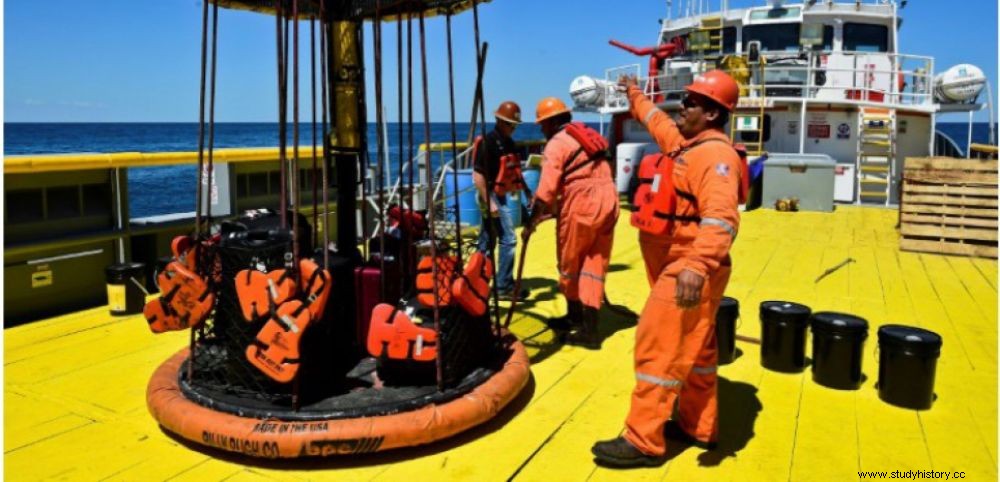 Scientists on a platform in the Gulf of Mexico on May 7, 2016
Scientists on a platform in the Gulf of Mexico on May 7, 2016 CRATER. In the calm, crystal-clear waters of the Gulf of Mexico, 30 meters above the waves, scientists around the world are drilling through the depths of the sea to find the remains of the asteroid believed to have caused the extinction of the dinosaurs. In April 2016, 33 kilometers off the coast of Yucatán, Expedition 364 began, with a budget of 15 million dollars. For the first time, an impact crater submerged in the ocean is observed by scientists. The platform, surrounded by waves and sharks, is erected above the Chicxulub crater, a cavity 200 km in diameter formed by an impact 66 million years ago, during the Cretaceous period. The asteroid hit the Earth's surface at a speed of 30 km per second.
In this 2,000 m 2 laboratory , about thirty geologists, paleontologists and microbiologists from North America, Asia and European countries are looking for micro-fossils or pulverized remains of the asteroid from the orbits of Mars and Jupiter. These discoveries could help them solve the mystery of this cataclysm. "One of the exciting questions is that of the origin of the environmental changes that caused the mass extinction and then the biological recovery in the Paleogene period ", explains Sean Gulick, from the Institute of Geophysics at the University of Texas. After this huge collision, the fireballs fell on Earth, which was then enveloped by the asteroid fragments and became cold and dark. . "When the solar radiation was blocked, photosynthesis halted and a chain extinction began. Several months later, the dust fell [...] and changed the chemistry of the oceans which became more acidic ", says Jaime Urrutia, president of the Mexican Academy of Sciences and responsible for the mission.
According to part of the scientific community, the asteroid would not be the only cause of the extinction of the dinosaurs. However, everyone agrees that this collision caused the disappearance of 75% of living species and major upheavals in the evolution of the planet. Chicxulub, discovered in the 1970s during explorations by Mexican Petroleum (Pemex), is the most recent and best-preserved impact crater. Apart from its historical importance, this site also has a mysterious peculiarity:near its center stands a circular mountain range 500 meters high and with a radius of about 30 km. This cordillera is known as the "ring of peaks". "The rocks inside the ring of peaks are so fractured that it is thought that very high temperature fluids could have flowed [through the rocks], with this observation we might anticipate that this was a privileged place for microbial life ", explains Gulick.
A noisy exploration of the Chicxulub crater
On the summit of one of the mountains of the cordillera is fixed the Myrtle platform. This is where scientists from the International Ocean Discovery Program (IODP) and Continental Drilling (ICDP) work around the clock. The strident sounds of heavy machinery are continuous. Wearing uniforms and safety helmets, the researchers communicate with each other by gestures or shouts. While two cranes transport people and material from a boat, the drilling continues. A powerful drill penetrates 1.5 km deep into the rock strata formed millions of years ago, then a kilometer tube extracts the samples. The mission will end at the beginning of June. The rocks collected and analyzed will then be taken to Bremen, Germany, where the scientists will write up their findings. Enthusiasm for the mysteries of the Gulf of Mexico is not shared by fishermen in Yucatán who say the sound of the drill scares away grouper, gudgeon and other fish from the area.
